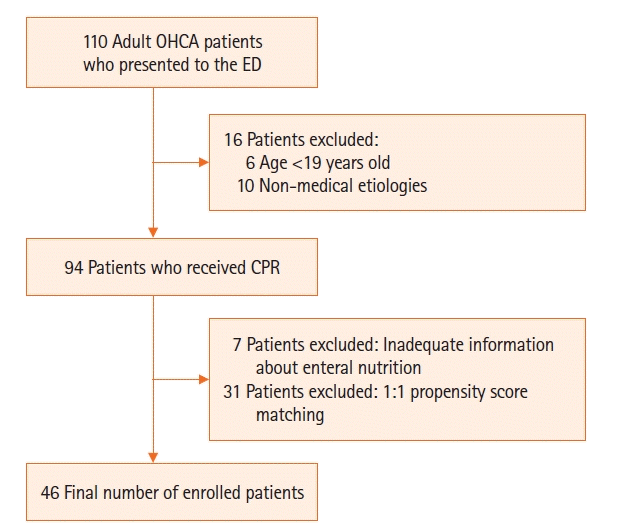1. Kang Y. Management of post-cardiac arrest syndrome. Acute Crit Care. 2019; 34:173–8.

2. Panchal AR, Bartos JA, Cabañas JG, Donnino MW, Drennan IR, Hirsch KG, et al. Part 3: adult basic and advanced life support: 2020 American Heart Association guidelines for cardiopulmonary resuscitation and emergency cardiovascular care. Circulation. 2020; 142(16_suppl_2):S366–468.
3. Choi YH, Lee DH, Oh JH, Wee JH, Jang TC, Choi SP, et al. Renal replacement therapy is independently associated with a lower risk of death in patients with severe acute kidney injury treated with targeted temperature management after out-of-hospital cardiac arrest. Crit Care. 2020; 24:115.

4. Tan BK. Extracorporeal membrane oxygenation in cardiac arrest. Singapore Med J. 2017; 58:446–8.

5. Yannopoulos D, Bartos J, Raveendran G, Walser E, Connett J, Murray TA, et al. Advanced reperfusion strategies for patients with out-of-hospital cardiac arrest and refractory ventricular fibrillation (ARREST): a phase 2, single centre, open-label, randomised controlled trial. Lancet. 2020; 396:1807–16.

6. Castedal M, Björnsson E, Abrahamsson H. Effects of midazolam on small bowel motility in humans. Aliment Pharmacol Ther. 2000; 14:571–7.

7. Nimmo WS, Heading RC, Wilson J, Tothill P, Prescott LF. Inhibition of gastric emptying and drug absorption by narcotic analgesics. Br J Clin Pharmacol. 1975; 2:509–13.

8. Tamion F, Hamelin K, Duflo A, Girault C, Richard JC, Bonmarchand G. Gastric emptying in mechanically ventilated critically ill patients: effect of neuromuscular blocking agent. Intensive Care Med. 2003; 29:1717–22.

9. Maday KR. The importance of nutrition in critically ill patients. JAAPA. 2017; 30:32–7.

10. Mehta Y, Sunavala JD, Zirpe K, Tyagi N, Garg S, Sinha S, et al. Practice guidelines for nutrition in critically ill patients: a relook for Indian scenario. Indian J Crit Care Med. 2018; 22:263–73.

11. Taylor BE, McClave SA, Martindale RG, Warren MM, Johnson DR, Braunschweig C, et al. Guidelines for the provision and assessment of nutrition support therapy in the adult critically ill patient: Society of Critical Care Medicine (SCCM) and American Society for Parenteral and Enteral Nutrition (A.S.P.E.N.). Crit Care Med. 2016; 44:390–438.

12. Howes D, Gray SH, Brooks SC, Boyd JG, Djogovic D, Golan E, et al. Canadian Guidelines for the use of targeted temperature management (therapeutic hypothermia) after cardiac arrest: a joint statement from The Canadian Critical Care Society (CCCS), Canadian Neurocritical Care Society (CNCCS), and the Canadian Critical Care Trials Group (CCCTG). Resuscitation. 2016; 98:48–63.

13. Hoffmann M, Schwarz CM, Fürst S, Starchl C, Lobmeyr E, Sendlhofer G, et al. Risks in management of enteral nutrition in intensive care units: a literature review and narrative synthesis. Nutrients. 2020; 13:82.

14. Joo WJ, Ide K, Kawasaki Y, Takeda C, Seki T, Usui T, et al. Effectiveness and safety of early enteral nutrition for patients who received targeted temperature management after out-of-hospital cardiac arrest. Resuscitation. 2019; 135:191–6.

15. Taylor SJ, Fettes SB, Jewkes C, Nelson RJ. Prospective, randomized, controlled trial to determine the effect of early enhanced enteral nutrition on clinical outcome in mechanically ventilated patients suffering head injury. Crit Care Med. 1999; 27:2525–31.

16. Ichimaru S. Methods of enteral nutrition administration in critically ill patients: continuous, cyclic, intermittent, and bolus feeding. Nutr Clin Pract. 2018; 33:790–5.

17. Madden LK, Hill M, May TL, Human T, Guanci MM, Jacobi J, et al. The implementation of targeted temperature management: an evidence-based guideline from the Neurocritical Care Society. Neurocrit Care. 2017; 27:468–87.

18. Tian F, Heighes PT, Allingstrup MJ, Doig GS. Early enteral nutrition provided within 24 hours of ICU admission: a meta-analysis of randomized controlled trials. Crit Care Med. 2018; 46:1049–56.
19. Edington J, Boorman J, Durrant ER, Perkins A, Giffin CV, James R, et al. Prevalence of malnutrition on admission to four hospitals in England. Clin Nutr. 2000; 19:191–5.

20. Correia MI, Waitzberg DL. The impact of malnutrition on morbidity, mortality, length of hospital stay and costs evaluated through a multivariate model analysis. Clin Nutr. 2003; 22:235–9.

21. Alberda C, Gramlich L, Jones N, Jeejeebhoy K, Day AG, Dhaliwal R, et al. The relationship between nutritional intake and clinical outcomes in critically ill patients: results of an international multicenter observational study. Intensive Care Med. 2009; 35:1728–37.

22. Mogensen KM, Robinson MK, Casey JD, Gunasekera NS, Moromizato T, Rawn JD, et al. Nutritional status and mortality in the critically ill. Crit Care Med. 2015; 43:2605–15.

23. Kim YM, Jeung KW, Kim WY, Park YS, Oh JS, You YH, et al. 2020 Korean guidelines for cardiopulmonary resuscitation. Part 5. Post-cardiac arrest care. Clin Exp Emerg Med. 2021; 8(S):S41–64.

24. Martin M, Reignier J, Le Thuaut A, Lacherade JC, Martin-Lefèvre L, Fiancette M, et al. Nutrition during targeted temperature management after cardiac arrest: observational study of neurological outcomes and nutrition tolerance. JPEN J Parenter Enteral Nutr. 2020; 44:138–45.

25. Gutierrez A, Carlson C, Kalra R, Elliott AM, Yannopoulos D, Bartos JA. Outcomes associated with delayed enteral feeding after cardiac arrest treated with veno-arterial extracorporeal membrane oxygenation and targeted temperature management. Resuscitation. 2021; 164:20–6.

26. Reintam Blaser A, Starkopf J, Alhazzani W, Berger MM, Casaer MP, Deane AM, et al. Early enteral nutrition in critically ill patients: ESICM clinical practice guidelines. Intensive Care Med. 2017; 43:380–98.





 PDF
PDF Citation
Citation Print
Print




 XML Download
XML Download